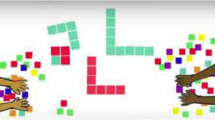Abstract
The importance of blocks for young children has been recognized throughout the history of the kindergarten movement. Their use as a learning material first appeared in the 16th century as alphabet “dice” designed by Sir Hugh Plat (Godfrey, 1907). Froebel (1782–1852), the Father of the Kindergarten praised their importance as a building activity and applied them as learning agents in his curriculum. Since his teachings and writings, in this area, the advantages and values inherent in blocks have been continuously cited by educational writers (Hendrick, 1988; Hirsch, 1984; Seefeldt, 1984).
Similar content being viewed by others
References
Abrams, M.H. (1953).The mirror and the lamp. Oxford University Press.
Bruner, J. (1973).The relevance of education. New York: Worten Press.
Flannery, M. (1974). Aesthetic education.Art Education, 26 10–14. Gardner, H. (1980).Artful scribbles: The significance of children's drawings. New York: Basic Books.
Godfrey, E. (1907).English children in the older time. London: Mehuen & Co.
Hendrick, J. (1988).The whole child. St. Louis, MO: C.V. Mosby.
Hirsch, E. S. (1984).The block book. Washington, D.C.: National Association for Education of Young Children.
Lowenfeld, V., & Brittain, W. L. (1982).Creative and mental growth. New York: Macmillan.
McFee, J. (1972).Preparation for art. Belmont, CA: Wadsworth Publishing.
Perkins, D. (1984).The minds best work. Boston, MA: Harvard University Press.
Seefeldt, C. (1984).Teaching young children. New York: Prentice-Hall.
Additional information
Jeffrey I. Gelfer is Assistant Professor of Early Childhood Education at the University of Nevada in Las Vegas.
Rights and permissions
About this article
Cite this article
Gelfer, J.I. Discovering and learning art with blocks. Early Childhood Educ J 17, 21–24 (1990). https://doi.org/10.1007/BF01623194
Issue Date:
DOI: https://doi.org/10.1007/BF01623194




